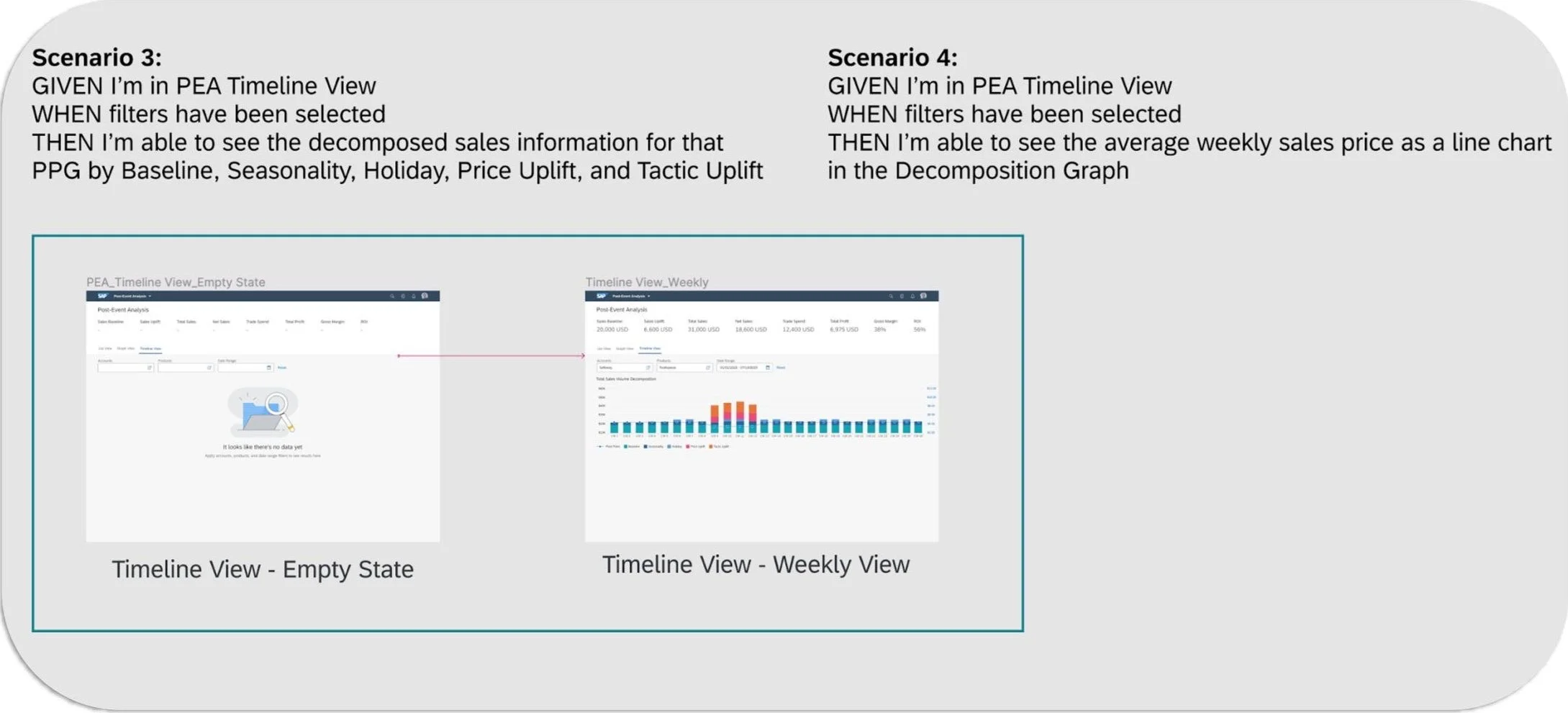Revenue Growth Optimization
CATEGORY
DESKTOP APPLICATION
DURATION
7 MO
YEAR
2021
FEATURE OVERVIEW
ROLE
TASK
RESPONSIBILITIES
Discovery Phase
Conducted user interviews and design thinking workshops to build personas and better understand user pain points
SAP’s Revenue Growth Optimization project focuses on monitoring and recommending promotion plans with higher accuracy and intelligence while maximizing trade spend.
Co-lead product designer
Lead design efforts in building out the post-event analysis feature of the product.
Recruit participants through Respondent, conduct 20+ hours of interviews and design thinking workshops, synthesize research data, designed low to high fidelity mocks, iterated on designs based on customer feedback, collaborate with the other other lead designer to ensure our features worked well together.
The Process
Lab Phase
Created high fidelity mocks to showcase multiple solutions to solve the problem space
Build Phase
After multiple rounds of iteration, the feature started being built by the engineer team
Market Release
GA release for this product was planned for 2022
Project contextDiscovery phase pt. 1We started this project with a product concept from leadership, but didn’t have market research to back up the idea which was our first step in the discovery phase.
discovery phase pt. 2With a stronger understanding of the problem space, we broke the team up to create different features with my team’s focus being post-event analysis.
Lab phaseWith a better understanding of product requirements, we went into brainstorming concepts and creating mocks.
build phaseFollowing multiple rounds of iteration, we entered the build phase where I provided design support for engineering as they took on building out the designs.
market releaseThis product was planned for general release in 2022.
→Innovation within SAP
As part of the SAP Innovation Center team, SAP’s Newport Beach office has teams focusing on defining retail industry problems and creating innovative solutions specifically within the retail planning and execution space. The Revenue Growth Optimization project is part of a larger effort to create a suite of Revenue Growth Management tools which started in July 2020. The final post-analysis feature that I lead will allow users to view important KPIs to better understand promotion gaps and performance.
Searching for Market Trends
We conducted interview sessions with account managers and revenue growth managers to start understanding if there is a need for this type of product in the current market. Through our sessions we were able to identify a major gap in managers being able to efficiently and effectively keep track of their major KPIs to set promotion prices.
Trade spend often exceeds 20% or more of total revenue.
72% of all trade promotions within the US don’t break even.
67% of all consumer goods companies can’t predict promotional outcomes.
80% of next year’s promotion plan is based on last year’s.
Problem Space
Collecting data on the reality of running and tracking promotion cycles helped us pinpoint our problem space and formulate a driving question for this product.
How can we help end users accurately measure promotion effectiveness and create promotion plans that accurately and optimally meet targets?
Research Goals
Coming onto this project our team had a limited understanding of how this feature was going to take shape and needed to conduct research to dive deeper.
Identify our key personas
Understand and define capabilities for post-analysis feature
Define decomposition feature
Research Outcomes
We identified our key personas as revenue growth managers and key account managers through interview sessions asking customers about their promotion process and which role is primarily in charge of those tasks. Once we understood more what the process consists of, we were able to start defining our feature’s purpose as:
Creating actionable analysis for users to see promotion plan performance at once glance and identify causes of poor performance on various aggregation levels.
From Brainstorming to Mocks
We kicked off the lab phase by me leading a Crazy 8 design exercise with my product manager to start ideation around how might we better identify patterns in promotions, price, and assortment?. These ideas were then turned into mocks which we used in design thinking workshops to get input on our current vision.
Design Thinking Workshops
The purpose of these workshops is to involve customers from the get go to ensure we are building a product for our users by our users. All the design thinking workshops were conducted over a span of 3 days. Day 1 is focused around what is the problem?. During this session we focused heavily on personas and outlining the As-Is process for a given task. Day 2 is more future thinking where we start ideating with the customer on what the To-Be journey could look like. We wrap up with Day 3 where we show design concepts based on the To-Be flow we collaborated on and gather feedback on what they think.
Coding the Designs
Once the designs were at a good point, the engineering team started pulling them into their sprints. I provided support by co-leading bi-weekly refinement sessions with the whole engineer team and weekly syncs with front-end developers to ensure there was clarity on what was being built. I organized the Figma files by user stories to help build the holistic view on how the workflow was laid out.












